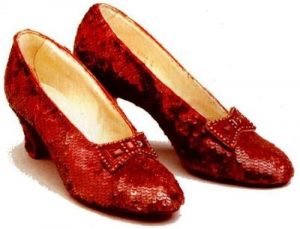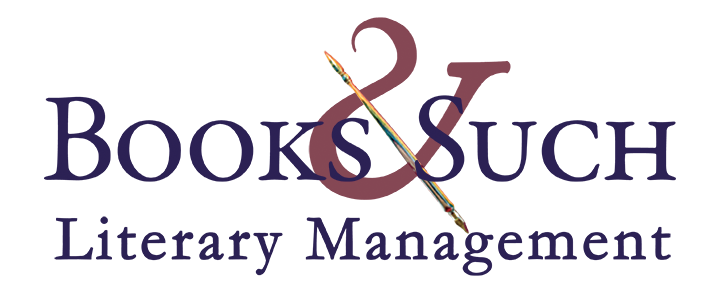Blogger: Janet Kobobel Grant
Recently my book club took a Dashiell Hammett tour of San Francisco. We ate at John’s Grill (which appears in The Maltese Falcon, the book our club read in preparation for the tour). The guide has been leading Dashiell Hammett tours for 30 years and was a fount of knowledge about not only Hammett but also Lillian Hellman (who was Hammett’s long-term lover), the history of mystery writing, and the current state of publishing. Despite the physical challenge of taking a walking tour in San Francisco (up steep hill, down steep hill), the time was enthralling.
One of the comments Don, our guide, made was regarding the importance of icons in a novel. He used the figure of the Maltese falcon as an example. That started my mind swirling to come up with other icons that were introduced in literature and have become a part of our culture.  Dorothy’s red shoes and Scarlett O’Hara’s Tara belong on that list.
Dorothy’s red shoes and Scarlett O’Hara’s Tara belong on that list.
What do I mean by icon? The traditional meaning is a religious symbol; some of these symbols are believed to be imbued with spiritual power, others not. The cross is an icon.The Silver Chalice (which was a novel and then a film in the 1950s centered on the cup Jesus used at the Last Supper) is an icon.
A more contemporary understanding of icon is a symbol that communicates a certain meaning. The Maltese falcon symbolizes the lust for riches; Dorothy’s shoes symbolize an adventure to another land while longing to return home. The films of both of these books were instrumental in making the bird and the shoes iconic. Nowadays we speak of “icons” as computer symbols that we click on to get to Twitter or Word.
What does an icon have to do with your writing?
Once a person is published, he or she soon realizes that merely being published isn’t enough to keep a career alive. The next step is to figure out how to break out from the pack; how to develop momentum and build on a strong foundation.
One of the ways to purpose to break out–or to break into publishing–is to write a manuscript centered on a powerful image. The book’s readers are the ones who make the image into an icon, but without the image, there is no icon.
Imagery is important in nonfiction as well as fiction
That’s especially today, when story often is an elemental part of successful nonfiction. I Know Why the Caged Bird Sings conveys, even in its title, a powerful image.
If I think back on books that endured on best-seller lists, often–though certainly not always–the book titles contained an evocative image. In nonfiction I recall Three Cups of Tea by Greg Mortenson and David Oliver Relin and Oprah by Kitty Kelley, which reminded me that a person as well as an object can be an icon. In fiction, The Girl with the Dragon Tattoo conveys the iconic importance of tattoos in current culture. And The Underground Railroad by Colton Whitehead uses an iconic American image, but the author gives it a twist by making it a literal underground train to freedom, fraught with the dangers of that perilous journey many are still traveling.
TWEETABLES
How to write a breakout book. Click to tweet.
Using icons to make your writing stand out. Click to tweet.
What books can you think of that have center on a powerful image? And the much bigger question, do you have a powerful image at the core of your work in progress?

Well, of course there’s “The Cross And The Switchblade”.
Ohhhhhh, yeah!
Tamara Leigh’s Age of Faith series is set in medieval times and features the Wulfriths, brothers who train boys into men, and sisters who defy the gentility of the age.
When men are knighted, they’re given a Wulfrith dagger, a prize valued for the difficulty in obtaining it, and a sign that the man carrying it is bound by honour and strength.
Any of Tamara’s readers can tell you all about that dagger!
*
I guess one image in my current WIP could be the long hair of each of the brothers. In most Native American cultures, long hair on a man is a sign of strength, and of adherence to traditional practices. In each of the 3 books in my current series, the MC’s hair, and the state of it during the story, tells a story of its own. The most humiliating thing to happen to a Navajo warrior would’ve been to cut his hair short.
Maybe I did that, hmmmm.
Jesus was Master of the icon: the Good Samaritan, the second mile, the other cheek, the prodigal son. Jesus, the Word become flesh, used his words well.
So true, Shirlee. There’s also the water into wine, 3 loaves and 2 fishes…so many iconic images!
I was talking to my girls about this. They mentioned Cinderella’s glass slipper. Books I’ve read in more recent days … I think of Kristy Cambron’s The Butterfly and the Violin. Even mouse ears make me think of all things regarding glorious Disney. I do have an image for my works. Powerful? I pray so. When I speak to groups on surviving hardships, I refer to hardships as “gifts” … my prop is a huge gift box … my girls gave me a sterling silver gift box charm for my bracelet at Christmas. I needed the reminder–going through a rough season–that God is in control, He will use this situation some way, and I want the take advantage of the opportunity to draw closer to Him. Beauty will come out of the bad.
Oh, yes, the glass slipper is a perfect example of an icon!
And your gift book has all the necessary qualities to become iconic.
Are the ball bearings that Captain Queeg rolled in his hands (“Rub, rub, rub, went the little steel balls.”) throughout “The Caine Mutiny” still considered a cultural icon?
* In “Blessed Are the Pure Of Heart”, a roadside memorial cross plays a pivotal role, and I guess that is an icon of sorts. (And I have recovered the rights to BPH after the publisher went south…hard cheese for them, but I’m glad it’s coming home.)
Andrew: I think the steel balls, while they demonstrate Queeg’s mental condition, have too small a part to take the status of icon. That’s based on the movie version, not the book.
Good point, David.
I’m mot sure if this fits, but Aslan is a powerful image in the Chronicles of Narnia. He’s the first person I think of whenever a title from the series is mentioned.
*This post is making me think about my own books. The idea of icons is one I need to explore more.
I had that same thought. The first that came to my mind was “The Lion, the Witch, and the Wardrobe.”
The Holy Grail has been a powerful icon in a number of books and movies. The Indiana Jones movie comes to mind, along with The DaVinci Code
In my work-in-progress, Preserve The Revelation (first draft complete; will start editing soon), the protagonist comes into possession of both the original manuscript of John’s “Revelation” and the burial cloth that wrapped the head of Jesus in the tomb. He must defend these from two powerful men who seek to take them from him.
A book that did a wonderful job of this recently was the Mark of The King by Jocelyn Green. It was one of my favourite historicals of 2016. A branded fleur-de-lis tattoo impressed on those who had committed crimes and were sent to the new world ends up becoming a physical symbol for our inequity which only Christ’s grace and mercy can intercept.
like the best use of image, it was done in a lyrical way that never over-powered the story, rather it became a constant and stayed with be long after the last page was turned.
That sounds like it could develop into an icon. I love the symbolism behind it that Jocelyn developed throughout the novel.
Thank you, Janet. I’ve not considered the use of icons in my writing. I’m finishing up a manuscriot this week to be sent to Beta readers next week about silent sacred space, a meditative, contemplative practice I discovered on my own. I’m going to give the icon idea some thought. With religious nonfiction, it may take a different form. The cross is always powerful imagery. I’ll take it from there. This is a useful consideration. Love it!
Norma, I’m so glad this post started you thinking about icons. They can transform a nonfiction manuscript as well as a novel.
New concept to me as well. I’m toying the idea of a concept/phrase becoming an icon. Maybe something like Sheldon’s “What would Jesus do?”
In this article, the author discusses the importance of creating iconic characters in breakout books. They compare it to the way basketball players like Michael Jordan became icons through their signature moves, much like how Dunks have become a beloved sneaker brand. Just like Dunks, iconic characters have a lasting impact on readers and can make a book memorable. As writers, it’s important to create characters that are unique and leave a lasting impression on readers, just like how Dunks have made their mark in the sneaker world.